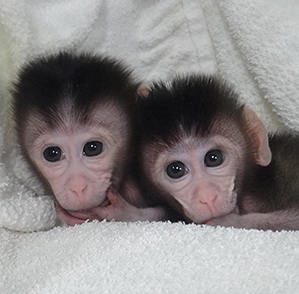Monkeys Modified with Genome Editing
Researchers at Nanjing Medical University and Yunnan Key Laboratory of Primate Biomedical Research in Kunming, China, have created genetically modified monkeys using a new method of DNA engineering known as Crispr. The infant macaques show that targeted genome editing is feasible in primates—a potential boon for scientists studying complex diseases, including neurological ones, and an advance that suggests that the method could one day work in humans. The work was reported in the journal Cell on Thursday.

Scientists have previously used the new genome-editing technique to delete, insert, and modify DNA in human cells and other animal cells grown in petri dishes. The method has also been used to create gene modifications in whole animals such as mice, rats, and zebrafish. The new study shows for the first time that Crispr can create viable primates with genomes modified at specific targeted genes.
The Chinese researchers injected single-cell macaque embryos with RNAs to guide the genome-editing process. The team modified three genes in the monkeys: one that regulates metabolism, another that regulates immune cell development and a third that regulates stem cells and sex determination, says study coauthor Wezhi Ji, a researcher at the Yunnan Key Laboratory of Primate Biomedical Research. The researchers found that the genome-editing tools created multiple changes in their target genes at different stages of embryonic development. The infant monkeys are too young for the team to yet determine if the genetic changes have an effect on physiology or behavior, says Ji. But, he adds, “data from this species should be very useful for curing human disease and improving human health.”
Researchers have previously created a handful of transgenic monkeys, such as a rhesus macaque that produces the disease-causing version of the Huntington’s gene. Researchers at Emory University in Atlanta created this avatar of human disease by injecting a virus into macaque eggs. The virus delivered a disease-version of the human Huntington’s gene into a random location in the monkey’s genome.

Crispr, on the other hand, can be used to insert, delete, or rewrite a DNA sequence at a specific location within a genome. Like the random viral insertion used by the Emory team, the Crispr method employed by Ji and colIeagues can create genetically modified animals in a single generation, an important consideration for researchers working with animals that can take three years to reach sexual maturity and are expensive and difficult to rear.
Others say they are anxious to use Crispr to create their own monkeys. Robert Desimone, director of MIT’s McGovern Brain Institute for Brain Research, says he and colleagues are planning on using genome editing to create modified monkeys. He says it’s possible the success of the Chinese researchers will encourage other groups to use primates in their work. “Although mice are giving us tremendous insight into basic brain biology and the biology of the disease, there’s still a big gap in between the mouse brain and the monkey brain,” says Desimone.
For example, he says, lots of drugs that work in mice to treat disease don’t work in humans. Desimone says he’s hoping that some success in monkeys will interest drug companies in neuroscience—alluding to a recent trend of large drug companies abandoning research on brain diseases because the work often proved unsuccessful. The hope is that disease and drug research in monkeys will more likely lead to therapies in humans because the primates share complex behaviors and social structures. “We are cautiously optimistic,” says Desimone.
The fact that genome editing worked to create modified monkeys suggests it might also work to create genetically modified humans. Crispr is already used to modify human cells grown in labs, but it has not yet been tested on human embryos or adults. “We believe the success of this strategy in nonhuman primates gives lots of potential for its application in humans, but we think due to the safety issue, it will take a long way for expanding this strategy to human embryos,” says Ji.
Nonetheless, some are already looking toward a future of genome editing in humans. Several U.S. pioneers of the Crispr system recently founded a startup that will attempt to develop cures for genetic disease using genome-editing technology (see “New Genome-Editing Method Could Make Gene Therapy More Precise and Effective”).
Keep Reading
Most Popular
Large language models can do jaw-dropping things. But nobody knows exactly why.
And that's a problem. Figuring it out is one of the biggest scientific puzzles of our time and a crucial step towards controlling more powerful future models.
The problem with plug-in hybrids? Their drivers.
Plug-in hybrids are often sold as a transition to EVs, but new data from Europe shows we’re still underestimating the emissions they produce.
Google DeepMind’s new generative model makes Super Mario–like games from scratch
Genie learns how to control games by watching hours and hours of video. It could help train next-gen robots too.
How scientists traced a mysterious covid case back to six toilets
When wastewater surveillance turns into a hunt for a single infected individual, the ethics get tricky.
Stay connected
Get the latest updates from
MIT Technology Review
Discover special offers, top stories, upcoming events, and more.